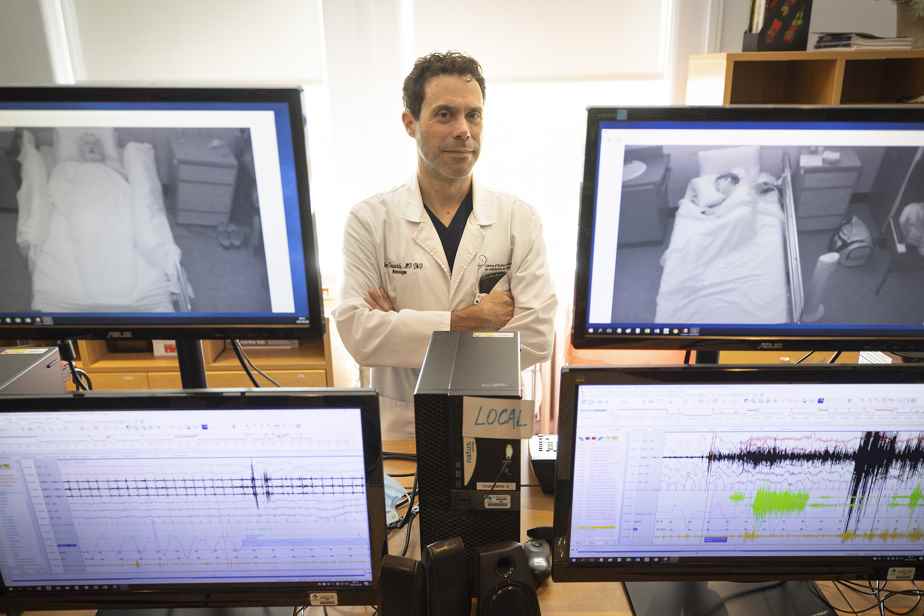Posted at 5:00 a.m.
dreams in action
During sleep, especially during the dreaming phase, the brain sends a particular command to the spinal cord: above all, do not move. “During REM sleep, we are paralyzed,” explains psychologist Charles Morin, sleep specialist at Laval University. “This muscle atony disappears in some people with age. So they make movements corresponding to their dreams. »
With colleagues from around the world, Mr. Morin has just published a study showing that in patients who have had COVID-19, the loss of this muscle atony is more frequent, particularly in those who have had more severe symptoms. This study was published in the Journal of Sleep Research. REM sleep is also called the “REM phase” rapid eye movement (rapid eye movement), and loss of muscle atony, RBD, for REM behavior disorder (REM sleep behavior disorder).

PHOTO PROVIDED BY CHARLES MORIN
Psychologist Charles Morin, sleep specialist at Laval University
Parkinson’s
RBD is potentially dangerous if the patient injures another person they sleep with (this problem is more often diagnosed in men). And in the longer term, a diagnosis of RBD leads, fifteen years later, in 70% to 80% of cases, to neurological diseases, including Parkinson’s, according to Alex Desautels, director of the sleep clinic at the Sacred Heart Hospital. “We have talked about olfactory impairment with COVID-19 and we know that people with Parkinson’s will have olfaction impairment before motor symptoms, says the neurologist. It is certain that the coronavirus causes an attack inside the brain. So the premise makes sense. »
Nightmares
Mr. Morin and his colleagues have also looked into nightmares. They observed that nightmares are twice as common in patients with COVID-19. “There also seems to be a better memory of dreams. It may be because of the change in sleep schedule. We must continue to examine the question. The nightmare study was published in January in the journal Nature and Science of Sleep. One in seven COVID-19 patients reported having nightmares over a three-day data logging period.
The long COVID
The Dr Desautels is also working on sleep and COVID-19. “We are taking care of the sleep portion of an international project on the long COVID at Sacré-Coeur, says the professor from the University of Montreal. Other centres, including the Montreal Clinical Research Institute, will look into cognitive aspects and lung function. »
flats
Less than a dozen patients with long-term COVID have been recruited in Montreal. For the moment, the Dr Desautels did not observe an increased risk of RBD in these patients. “Eventually, we are aiming for around fifty patients, we will be able to see better at that time,” he says. There may be an effect of anxiety or withdrawal from alcohol consumption, or many other variables that have changed with confinement. There is somnambulism with the fever, and confusional awakenings with the infections. Sometimes people think they move during sleep and it’s linked to other causes. »
The difficulty of having an accurate portrait of the prevalence of RBD also complicates matters, with population studies reporting variable rates, ranging from less than 5% to 25%. M. Morin’s study reports a risk of RBD two to three times higher in patients who have had COVID-19, compared to a control sample.
A natural experience
The ICOSS (International Study of Sleep during COVID-19) project was born in March 2020. “We are researchers from six countries who have realized that the effect of confinement on sleep and the circadian rhythm [le cycle quotidien de la fatigue et de l’éveil] was a natural experience, says Morin. Usually, we isolate people in caves to find out what happens when we change habits. There, we suddenly changed all the habits. A lot of people got up later because they didn’t have to go to the office. »
The first effects observed reported insomnia linked to anxiety and the difficulty of working while taking care of children deprived of school, but also of a recovery of “sleep debts”. “For people who slept only five or six hours a night, not having to commute to the office and going out at night really lengthened the sleep time,” Morin says.
Learn more
-
- 13%
- Prevalence of sleep disorders before the pandemic
Source: Laval University
- 28%
- Prevalence of sleep disturbances at the start of the pandemic
Source: Laval University

